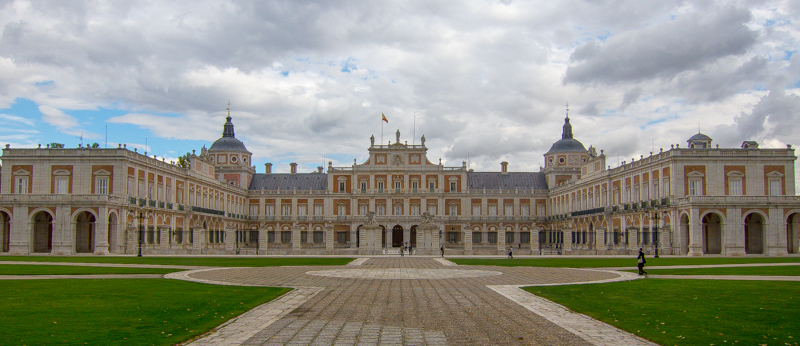Aranjuez is located in between of two rivers which are Vega del Tajo and Jarama. Those rivers and their canals irrigate fertile lands that are famous for its orchards and gardens. Spanish monarchs used to take care of this land while devoting their attention to Aranjuez to make it an ideal combination of their palatial buildings with splendid gardens and a large number of canals and fountains.
Their gardens are known for their outstanding botanical diversity since there are more than 400 species of trees and bushes, some of them are exceeding 50m in height and some of them have more than 260 years.
Because of all this, Aranjuez Cultural Landscape was declared a UNESCO World Heritage Site.
History of Aranjuez
It was settled in the zone of Encomienda de la Orden de Santiago (The Order of Santiago) with a house, a mill, stables for horse breeding and orchards in the 13th century. The place gained its importance in 15th century for being a place of hunting for the kings and later it was a place which was always passed in the trips by the catholic kings while travelling among Toledo, Madrid and Alcalá.
It was Carlos I who proposed to make Aranjuez an important place for rest and recreation of Royal house while taking into consideration the landscape management for hunting. Thus, demarcating The Royal Forest of Aranjuez and appointing an architect for the construction of royal site. His son Philip II continued the project while building the landscape of gardens, orchards, hydraulic structures and wide avenues of trees. It was a unique and innovative project which delighted celebrations of the court like hunting, boating, horseback riding, etc.
Monuments in Aranjuez
The entire Aranjuez is a huge monument, a unique historic landscape which is included in UNESCO World Heritage Site list.
Royal Palace of Aranjuez
Ferdinand II of Aragon (the Catholic) had already developed a system of Reales Sitios (Royal sites) and ordered to build a small Palace in Aranjuez by the 15th century. This palace became one of many places that Catholic kings used to visit.
The Palace of Aranjuez used to be occupied by Bourbons during most of the spring, while in the summer the court used to move to La Granja de San Ildefonso, in autumns to El Escorial and in winters to El Pardo or El Palacio Real of Madrid. Of course, every king had his own preferences during the long history.
Philip II continued this habit of moving but established the court in Madrid in 1561 and ordered to build his beloved palace of El Escorial, later ordered the same architects to build the one of Aranjuez.
Royal Church of San Antonio
It’s an interesting circular church with seven arches at the entrance and a circular dome with lantern.
It was originally the chapel of the Palace but only until 18th century when the present building was built in the style of Baroque.
There are porticos on both sides of the church that connect la Casa de los Infantes and la Casa de los Caballeros.
Aranjuez Train Station
The line Madrid-Aranjuez was established in 1851, it was the 3rd railway line. It was called Tren de Fresa (The Strawberry Train) because of the fame for growing this fruit.
The building of the station was built in 1924 of Neo-Mudéjar style (a type of Moorish Revival architecture). It was built by the same architect who accomplished Toledo 7 years ago.
Jardín del Príncipe Garden
This park of 145 hectares is flanked by the river Tajo. This land was purchased in 1535 by the crown in order to convert this land to orchards and gardens. Charles III created Jardín del Príncipe in 1772 which was later developed by his son, the Prince of Asturias who later became Charles IV. Then Juan de Villanueva built El Estanque Chinesco, La Montaña Artificial, 4 access doors 4 and La Casa del Labrador.
Jardín de la Isla Garden
It is a Renaissance garden which was designed by the initiative of Philip II in 1560 under the management of Juan Bautista of Toledo and later by Juan de Herrera, the same as El Escorial. Later these gardens were decorated by Philip III and Philip IV with the fountains of Hércules, Apolo, Baco and Neptuno.
Bullring
The bullring of Aranjuez dates back to the late 18th century. It was rebuilt in 1829 by the order of Ferdinand VII because its wooden bleachers and a deck had suffered a fire.
Other monuments of Aranjuez:
- Caserías Reales – Cortijo de San Isidro
- Jardines del Rey y de la Reina (the gardens of the King and the Queen)
- Casa de Oficio and Caballeros
- Church of Nuestra Señora de las Angustias de Alpajés
- Fuente de la Mariblanca
- Museum of Falúas and Casa de Marinos
- Hospital of San Carlos
- Casa de Infantes
Map of Aranjuez
Aranjuez is a town where it is better to walk on foot in order to enjoy the spectacular gardens. Here you can see some monuments that are interesting to visit.
View Aranjuez in a larger map





